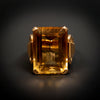Rijksmuseum acquires antique goldstone necklace
18.12.2023

Since a few years now, a Dordrecht boat necklace has been on display in the Special Collections of the Rijksmuseum, where all jewels are on display. The Rijksmuseum purchased this special Dutch boat necklace from our collection. Most often these necklaces are set with garnets, but our specimen is decorated with goldstone.The boat chain was made in Dordrecht either in 1701 or in 1722, which of the two is still being investigated. The necklace – one of the oldest known examples – is typical for Friesland, Groningen and Holland, but the use of faceted goldstone makes it extra special.About goldstoneGoldstone is not a gemstone, but glass with copper elements that has been made on the Venetian island of Murano since the second half of the 16th century. The glassmakers called goldstone 'avventurina', because producing it was more adventure than science. For example, it is known that a glass maker had fourty failed batches in one year.While imitations are normally named after their natural variant, this is exactly the opposite for the aventurine gemstone: goldstone, also called aventurine glass, already existed when the gemstone was first discovered.The boat chainThe gold necklace with faceted gold stones consists of thirteen links with filigree (wire work) and a lock. The necklace (36 cm, 21 grams) has three very legible hallmarks: the city hallmark for Dordrecht, the year letter K (1701 or 1722) and a maker's mark. Unfortunately, the plates with the Dordrecht hallmarks have been lost in the past, making it impossible in many cases to trace Dordrecht makers.












